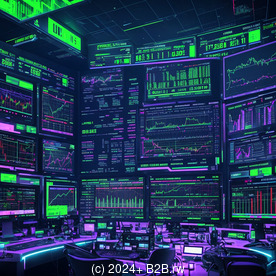
Understanding Data Visualization Tools in CMS Environments




General Considerations of Data Visualization Tools
Data Visualization Tools are powerful applications that facilitate the presentation of intricate data sets in formats that are easily comprehensible. Within Content Management Systems (CMS), these tools transform raw data into engaging visual formats, including charts, graphs, infographics, and dashboards. In an era where data-driven decision-making has become critical, the significance of these visualization tools cannot be overstated. They play a crucial role in helping stakeholders understand complex information, allowing them to derive actionable insights quickly and efficiently.
These tools enhance clarity and information retention, a key advantage given that humans are predominantly visual learners. When data is presented in graphical formats rather than in tabular details, it leads to faster comprehension, enabling stakeholders to identify trends, anomalies, and patterns swiftly and effectively. Furthermore, engaging visualizations can foster better communication and collaboration among team members, enhancing organizational effectiveness.
In today's fast-paced business landscape, the ability to convey information compellingly is vital. Data Visualization Tools empower organizations to respond promptly to challenges, foresee future trends, and seize opportunities rapidly. As a result, the techniques of data visualization are invaluable for both internal decision-making and external communications with clients and stakeholders. Enhanced decision-making processes rely on clear and immediate access to pertinent information, and data visualization tools help build a bridge between raw data and informed action.
Organizations that harness these tools effectively can improve operational efficiency, foster a culture of data-centric decision-making, and fundamentally enhance their ability to engage with their audience meaningfully. In a world awash with data, the capacity to visualize and interpret information can differentiate successful organizations from their competitors.




Insights on Data Visualization: Integrating Multiple Perspectives
Economic Perspective
From an economic standpoint, the integration of Data Visualization Tools offers substantial benefits for organizational performance. Businesses that leverage these tools streamline their data analysis processes, enabling quicker insight derivation and better resource allocation. Visualizing data trends and insights can lead organizations to conduct thorough cost-benefit analyses, unearth market opportunities, and enhance overall profitability. Moreover, effectively utilizing these tools often translates into reduced operational costs; employees equipped to interpret data efficiently spend less time on analysis and more time on strategic initiatives.
In practical terms, enhanced visual insights can lead to informed decisions that can reduce wasted expenditures or drive significant new revenue streams. A manufacturing company analyzing operational efficiency through visual reports can identify bottlenecks and optimize processes, ultimately increasing output and profit margins. A retail business identifying customer preferences through data-centric visualizations can tailor marketing strategies that effectively target and convert leads into loyal customers, thus maximizing return on investment (ROI).
Furthermore, the continual rise of e-commerce has intensified the need for real-time data visualization capabilities. Companies that can visualize and respond to customer behavior trends promptly can capitalize on emerging opportunities and alter product offerings or marketing messages to align with consumer demand.
Political Perspective
From a political viewpoint, organizations deploying data visualization technologies can significantly influence policy discussions and civic engagement efforts. By presenting complex statistics in easily digestible formats, organizations can effectively communicate the importance of pressing social issues, thus driving public and voter awareness. For instance, visualizing public health data can highlight critical trends and issues in healthcare, galvanizing support for policy changes or community initiatives.
This strategic use of visualization extends to advocacy groups or non-profits aiming to promote social justice and public welfare. Compelling visualizations can mobilize communities, attract media attention, and engage stakeholders in meaningful dialogue. By utilizing effective visual representation, advocacy groups can demonstrate the urgency and impact of issues such as income inequality, climate change, or healthcare access: visuals speak volumes where numbers may fall flat, casting a spotlight on the professionals and constituents involved.
Moreover, government agencies can leverage data visualization tools to transparently display statistics, budgets, and program outcomes, fostering trust among citizens and encouraging participation in public discourse. This openness can lead to more significant community engagement and enhanced accountability for decision-makers.
Social Perspective
On the social front, data visualization has the power to reshape internal team dynamics within organizations. By making data accessible through intuitive visuals, teams can foster a culture of openness and collaboration. Stakeholdersregardless of their technical backgroundscan engage with the data, contributing diverse perspectives to strategic discussions and fostering holistic decision-making. This culture of inclusivity is essential for cultivating innovative problem-solving methods, as it allows for a broader range of ideas and solutions to emerge.
Moreover, organizations that promote data literacy through visualization tools can empower employees, enhancing job satisfaction and engagement. When individuals understand how to interpret and utilize data effectively, their sense of ownership in projects and decisions increases. This empowerment has far-reaching implications: teams may feel more confident to pitch new ideas, challenge existing paradigms, or propose feasible solutions to longstanding problems.
Furthermore, the social implications extend beyond organizational boundaries; clients, partners, and stakeholders can derive greater understanding from data visualizations. For example, a company sharing annual reports through visually engaging formats can foster improved relationships with investors and increase overall trust and loyalty through clear communication.
Technological Perspective
The technological landscape significantly influences the development and functionality of data visualization tools. Recent advancementssuch as cloud computing and software-as-a-service (SaaS)have made sophisticated data visualization solutions more accessible and affordable for organizations of all sizes. This democratization allows smaller enterprises to harness powerful analytics capabilities without substantial upfront costs, leveling the playing field in competitive markets.
Furthermore, the integration of machine learning and artificial intelligence into data visualization tools enhances their efficiency and sophistication. Automated data cleansing, predictive analytics, and intelligent visual generation can streamline the user's workflow, allowing businesses to uncover insights without requiring extensive manual effort. These advancements enable users to generate more complex analyses effectively and intuitively interpret vast datasets.
As technology continues to evolve, the integration of embedded analytics into existing applications further allows users to embed visualization features directly into their workflows, fostering immediate real-time insights. The future roadmap for data visualization tools suggests even greater innovation, potentially incorporating augmented reality (AR) and virtual reality (VR) technologies to create immersive suite environments that allow deeper engagement with data.
Environmental Perspective
From an environmental standpoint, organizations can leverage data visualization to effectively monitor and report on sustainability metrics. Companies committed to social responsibility can visualize ecological data, track carbon footprints, and assess resource utilization. By presenting this information through engaging visuals, businesses can not only set clear sustainability benchmarks but also transparently communicate their progress to stakeholders.
For instance, a corporation might use interactive dashboards to publicly display its environmental impact data, enhancing credibility and accountability, which can, in turn, foster consumer trust and loyalty. By visualizing their sustainability efforts, companies can showcase improvements and hold themselves accountable to stakeholders invested in ethical practices.
Moreover, data visualization tools can facilitate strategic thinking around sustainability initiatives. By using visual tools to analyze waste reduction efforts or efficiency gains in resource use, companies can identify areas of improvement and track progress over time, ensuring that goals are met and sustainability becomes a core business principle.
Legal and Ethical Perspective
Legally, the rise of data visualization tools raises important considerations surrounding data privacy and security. Organizations must navigate complex legal frameworks that dictate the responsible handling of sensitive information, especially when presenting data involving personal identifiers. Transparency in data use, especially through visual representation, is key to maintaining trust with clients and complying with regulations like GDPR or HIPAA. Compliance with these regulations protects the organization and builds customer confidence in their data usage practices.
Moreover, ethical data visualization emphasizes accuracy and fairness, ensuring that visual metrics do not mislead or misrepresent the underlying data. Maintaining integrity in data visualization is imperative, as poorly designed visuals can evoke misleading interpretations that exacerbate public distrust. Organizations must remain vigilant in how they represent data visually, as ethical lapses can damage credibility not just for the organization but also for the field of data analysis as a whole.
Organizations can adopt a set of best practices for ethical data visualizationencouraging transparency in data sourcing, maintaining clarity in representation, and fostering an environment of scrutiny where team members can challenge and improve visual representations of data. The goal should be to present data that encourages informed decision-making rather than manipulated views of reality.




The Core Topic: Data Visualization Tools - Enhancing Data Presentation in CMS Environments
Data Visualization Tools serve as essential elements in effectively presenting and synthesizing data within CMS environments. These tools enable organizations to visualize various types of data interactions and analytics derived from user activities, purchase histories, website traffic patterns, and more. For entities that manage substantial datasetssuch as e-commerce platforms, academic research institutes, or governmental agenciesdata visualization tools are indispensable for understanding and leveraging information.
When communicating with potential buyers, it is crucial to highlight both the technical aspects and marketing value of data visualization solutions. Using diverse visualization types such as heatmaps, scatter plots, bar charts, and dashboards enables organizations to tailor visualizations to the specific narratives they wish to convey. This flexibility empowers stakeholders to easily dissect performance metrics, assess key performance indicators (KPIs), and catch trends across different dimensions of the data.
**Challenges Addressed**: Complex data analysis often presents various challenges for organizations. Employees may find it difficult to interpret massive datasets, leading to missed insights or erroneous conclusions. Data Visualization Tools mitigate these challenges by simplifying the data landscape, presenting information visually and systematically. For example, transforming quarterly sales data into a color-coded bar chart allows users to immediately see periods of growth and decline, facilitating more informed forecasting for strategic planning. This shift from raw data to easily interpreted visuals can ultimately lead to smarter business decisions that are steered by clear insights.
**Advantages of Data Visualization**:
- Improved Clarity: Visual representation clarifies complex information, making it easier for diverse audiences to comprehend.
- Enhanced Decision Making: With responsive dashboards, users can interpret critical data points quickly, expediting the decision-making process.
- Increased Audience Engagement: Visually stimulating graphics foster a higher level of audience engagement in meetings, presentations, and reports, encouraging questions and deeper exploration of the material.
- Interactive Exploration: Many visualization tools offer interactive features, allowing users to dive deep into datasets and explore various layers of insight at their own pace.
**Examples of Solutions**: Popular data visualization tools that integrate seamlessly with various CMS environments include Tableau, Microsoft Power BI, Google Data Studio, and D3.js. These flexible platforms not only enhance the visualization capabilities of an organization but also support the decision-making process by providing insightful analytics and reporting functionalities. Furthermore, these tools often allow for customization and branding, enabling organizations to present data in a style that aligns with their existing marketing strategies.




Conclusion: Investing in Data Visualization Tools for Enhanced Data Presentation
Data Visualization Tools represent a vital investment for organizations seeking to capitalize on the power of data in their operational and strategic processes. By facilitating enhanced communication of complex information, these tools empower employees and elevate overall corporate performance. As the significance of data-driven insights continues to expand, the role of effective visualization becomes increasingly critical in facilitating meaningful interpretation and presentation of this information.
The ability to display data visually not only aids in internal communication but also plays a pivotal role in external stakeholder engagement, whether that be clients, investors, or community partners. Companies that adopt data visualization tools are better positioned to make informed decisions that drive collective alignment and enhance organizational performance.
Moreover, as the business environment becomes increasingly competitive, embracing data visualization skills will lead to enhanced responsiveness to market dynamics, leading to innovative solutions that can meet and exceed customer expectations. Organizations that invest in data visualization solutions not only improve operational efficiencies but also enhance strategic planning and foster increased engagement with both internal and external stakeholders. In the modern data landscape, prioritizing effective data presentation is essential for maintaining a competitive edge and ensuring organizational agility in an ever-changing marketplace.
Unlock the Power of Data Visualization Today!
If you're interested in learning more about our data visualization solutions tailored for your CMS needs, feel free to contact us at www.b2b.rw using email, phone, or our online form. For those ready to elevate their data presentation strategies, the price for our comprehensive Data Visualization Tool package starts at $850 . Please proceed to our Checkout Gateway and utilize our Payment Processor to remit the amount of $850 in favor of our Company. Once you have completed your payment, kindly reach out to us with your payment receipt and your details to arrange your Data Visualization Service. Thank you for your interest in enhancing your data capabilities!
